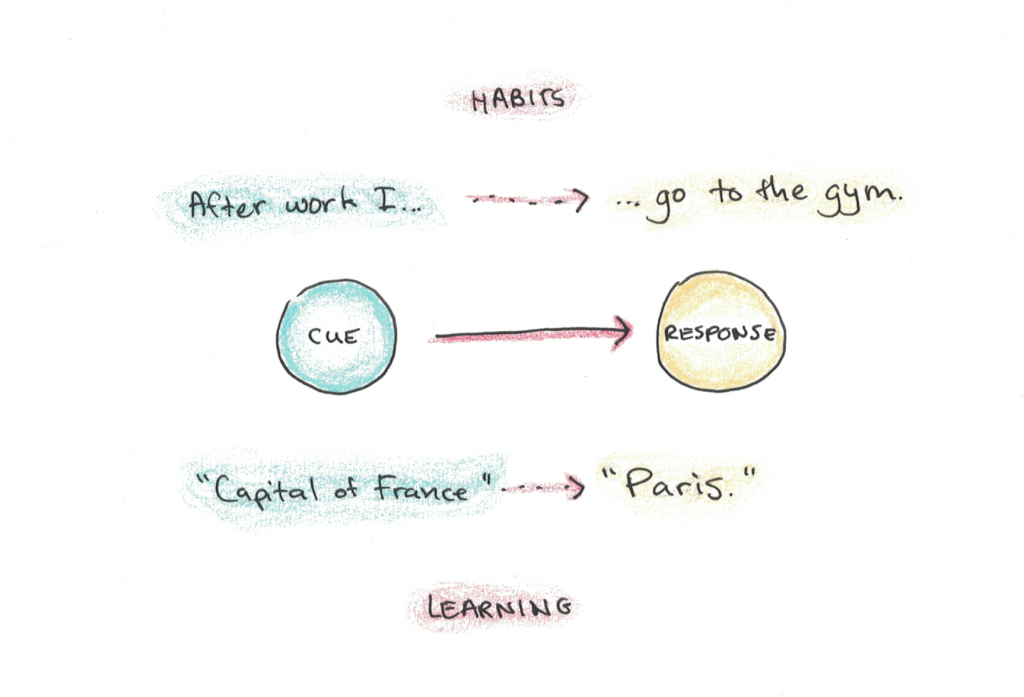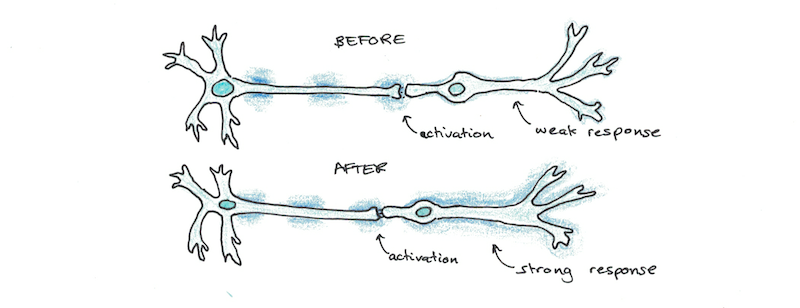Learning and habits seem like to separate facts about our psychology. Learning is about knowledge, information and skills. Habits are about routines, behaviors and actions.
However, I think the two actually work on mostly the same principles of the brain, and recognizing this connection can help you both learn better and form better habits.
Learning = Habits
To see the connection, let’s start by asking what a habit is. A habit is a semi-automatic behavioral response, given a certain set of cues in the environment. In other words, when you say you have a habit you mean something of the form “Whenever X happens, I do Y.” Examples:
- I go to the gym every day = “Every day after work, I go to the gym.”
- I don’t eat meat = “Whenever there’s meat in something, I don’t eat it.”
- I have a reading habit = “Whenever I have free time, I tend to read (as opposed to something else)”
Informally, habits can be more complicated than a 1:1 association. A regular exercise “habit” may, in fact, be multiple such associations of varying complexity, for instance:
- “When I plan my day, I always put in exercise.”
- “If the day is nearly over, and I haven’t exercised yet, I exercise.”
- “I go after work, except if I have other activities, in which case I go in the morning.”
Although some habits are actually just a simple cue and response, most are complex, dealing with specific sub-cases and having rules for certain situations that get embedded so they work most of the time. A habit doesn’t need to be 100% coupled to count, either. A voracious reader may not have a habit that says “whenever X happens, I must read,” but simply a tendency to read more when there’s spare time.

Learning, it turns out, is almost exactly like this. To learn something means you produce some kind of response (mentally or physically) when given a set of cues. Examples:
- I know the capital cities of every state = “When state X is mentioned, in context of asking for the capital city, I produce the correct city, Y.”
- I can speak Chinese = “When someone speaks to me in Chinese, I produce an appropriate response.”
- I can ski downhill = “When I’m falling down on my skis, my body automatically produces the motor actions that will get me to the bottom safely.”
This may sound hand-wavey, because these examples are so much more complicated and nuanced than simple habits. But as I mentioned before, habits are also often quite complicated, with varying responses for different situations and sometimes only probabilistically so, rather than a completely automated response to a situation.
Conscious Control Versus Automatic Action
One seeming difference between learning and habits may be that applying what you’ve learned is a more conscious process, whereas a habit is thought to be mostly automatic.
An expert painter, for instance, doesn’t just splatter paint on autopilot. Every stroke is a deliberate effort to achieve a particular result. This deliberateness seems the complete opposite of habits, which are defined by their level of automaticity.
While this seems to be the case, I’m also inclined to believe it’s more a superficial difference than it first appears. Even in simple habits, there’s often a great deal of flexibility about how to execute it. Take something like exercising every day: should you go in the morning or afternoon? Run or lift weights? Push yourself or take it easy?
Of course, a habitual action tends to have a strong default (otherwise it wouldn’t be a habit), but this too is similar to learning. When you encounter a familiar problem, the overriding tendency is to apply the techniques you’ve learned before. To solve a problem in an original way takes effort the same way that breaking out of a habitual groove does.
The Neuroscience of Learning and Habits
There’s a lot we don’t understand yet about both learning and habit-formation in the brain. But a common principle to both seems to be selectively strengthening the connections between neuronal circuits that lead to the desired output, and weakening incorrect or spurious connections.
A habit forms when a sequence of neurons fire forms a strong connection with downstream synapses and thus when the earlier ones fire, the later ones fire with a high probability. Think of this like a river carving a valley into the ground, so the water flowing downhill will be exceedingly likely to follow a certain path.

Learning happens when associations of one long-term memory become tightly coupled with another. This can be as simple as a cue-response: “Q: What is the capital of France? A: Paris.” or it can be as complicated as solving a differential equation by having the forms of the differential equation automatically flow to the mental actions that begin to solve it.
While there is likely quite a bit of nuance in each of these broad categories, my suspicion is that they overlap considerably, rather than being largely separate domains. Some forms of learning are encoded as motor sequences (such as learning to drive a car), some habits are encoded as associations between higher-level abstractions (such as remembering to write down to-do items when actions are discussed in an office meeting).
How to Use this to Learn Better (and Make Better Habits)
By seeing learning as similar to habit formation, you can start to view learning not as the process of storing information, but of preparing actions in particular contexts. So learning a language isn’t just storing vocabulary words, but learning to activate certain knowledge, in response to particular situations.
Once you see learning as cue-driven and context-based, as well as something that is trained like a habit (through repetition of the pattern of cue-response), then you’ll be much more likely to practice in a way that will eventually be useful. You’ll be able to spot inefficient learning designs when you recognize that the habit you’re creating isn’t the habit you actually need.
While it is true that you can’t anticipate every detail of a situation, it’s easy to recognize, for instance that a fundamental habit of mind which is useful when speaking a language is being able to think of an idea/concept and come up with the associate word in the language, but that picking that word out of a wordbox isn’t probably the habit you need (like in apps such as DuoLingo).
Similarly, you can improve your habit-formation by seeing it more like an act of learning. Rather than see your habits as being simple units, you can see that you’re trying to create flexible responses to a whole host of situations, all of which need to be conditioned separately. An exercise habit isn’t just going to the gym every day, but finding the appropriate response for all sorts of varied conditions (the gym is closed, you’re feeling sick, you forgot your running shoes, etc.)
By seeing habits-as-learning, you recognize that what you’re doing is not simply a matter of self-discipline, but also of exploration, experimentation and trying to create patterns of behavior that produce useful responses in situations you can’t quite predict. This takes time and practice, rather than simply being an act of will to execute.
Above all, by seeing the connection between learning and habits, you can see how much of your life is made up of similar patterns. Your thoughts, emotions, relationships and identity also operate on similarly practiced loops of cue and response. See the patterns, and you can start to change them.

 I'm a Wall Street Journal bestselling author, podcast host, computer programmer and an avid reader. Since 2006, I've published weekly essays on this website to help people like you learn and think better. My work has been featured in The New York Times, BBC, TEDx, Pocket, Business Insider and more. I don't promise I have all the answers, just a place to start.
I'm a Wall Street Journal bestselling author, podcast host, computer programmer and an avid reader. Since 2006, I've published weekly essays on this website to help people like you learn and think better. My work has been featured in The New York Times, BBC, TEDx, Pocket, Business Insider and more. I don't promise I have all the answers, just a place to start.